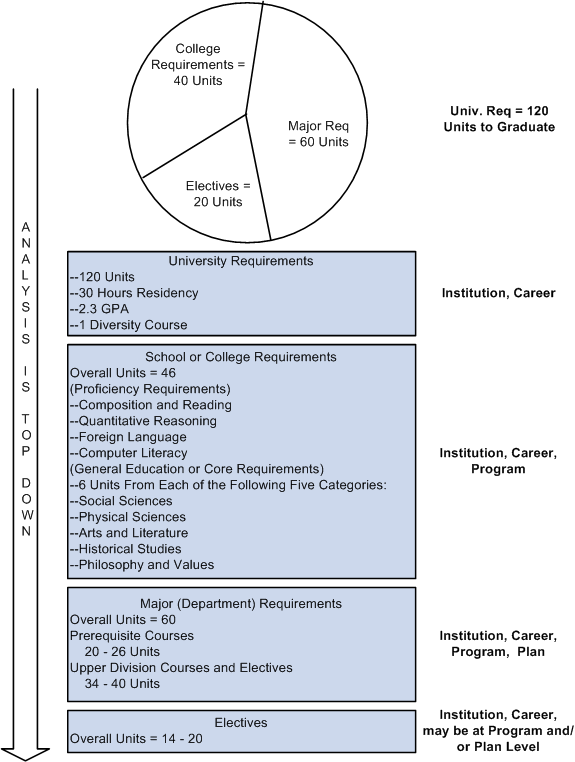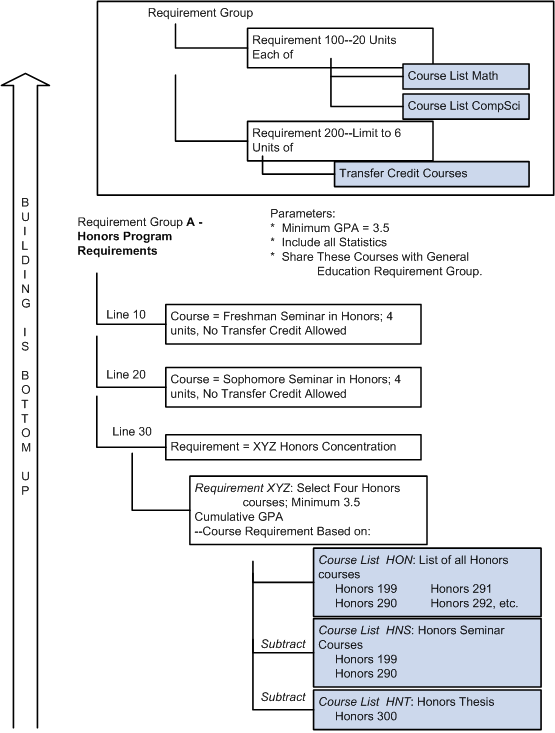 Understanding Academic Advisement Concepts
Understanding Academic Advisement Concepts
This chapter provides an overview of academic advisement concepts and discusses how to:
Outline the academic structure of an institution.
Calculate grade point averages.
 Understanding Academic Advisement Concepts
Understanding Academic Advisement Concepts
The building blocks of this versatile and effective degree audit system are course lists, requirements, and requirement groups. Academic requirement groups consist of academic requirements that are satisfied by course lists.
A course list is a group of courses that can be used to satisfy an academic requirement. By using the mathematical concepts of union, intersection, subtraction, and complement, course lists can interact in countless ways. As a result, different course lists interacting in different ways can often satisfy the same requirement. The system is designed to maximize the reuse of requirement groups, requirements, and course lists by means of set operations, including union (addition), subtraction, and intersection.
Academic requirements contain requirement parameters, pre-conditions, connector types, partitions, detail requisite, restrictions, and line item parameters. Requirements can be very simple (for example, the only required element may be a GPA of 3.000) or very complex (for example, the required elements may be expressed in multiple requirement line items using partition sharing).
Requirement groups consist of detail lines pointing to conditions, courses, and requirements as well as parameters that include unit and course requirements. The advisement engine evaluates each student's career, program, plan, and sub-plan (plus other pertinent academic data) and determines which requirement groups apply to that student.
Because of the underlying concepts used to establish requirements and to execute degree audits, Academic Advisement is a powerful yet flexible tool. The underlying structure relates to the use of the elements of academic structure.
Traditionally, the academic structure of an institution is built from the top level down (for example, the total number of units needed to graduate through specific requirements for programs and plans). This traditional approach to academic structure is still valid and very necessary; however, while making use of this approach, the Academic Advisement application is built from the bottom level up (for example, course lists are defined first, followed by academic requirements, then requirement groups).
Note. As mentioned, academic requirement groups consist of academic requirements that are satisfied by course lists. However, in order for the academic advisement portion of PeopleSoft Campus Solutions to work correctly, you must set up or establish the pages in the reverse order. First, define course lists, then set up academic requirements, and then establish requirement groups. Therefore, in the Academic Advisement navigation, the setup components are listed in this order: Define Course Lists, Define Academic Requirements, and Define Requirement Groups.
The following diagram presents a traditional four-year institution's degree requirements and the academic structure level at which the rules apply.

Traditional approach to academic advisement concepts (Part 1)
This diagram expresses the degree requirements (from the Part 1 diagram) using academic advisement concepts of course lists, requirements, and requirement groups.

Traditional approach to academic advisement concepts (Part 2)
 Outlining the Academic Structure of an Institution
Outlining the Academic Structure of an Institution
Before entering any data in the Academic Advisement pages, carefully outline the academic advisement structure of your institution. Think carefully about how the institution is structured, what degrees are offered, the requirements for those degrees, and how course lists are organized (for example, a statistics course list might consist of math courses as well as social science statistics or biological science courses, transfer equivalents, and test equivalents).
Important! Establish the academic advisement structure of your institution before entering any data on the academic advisement pages. Careful planning will save time and energy.

 Phase One: Outlining the Basic Advisement Structure
Phase One: Outlining the Basic Advisement StructureOutline your academic advisement structure as follows:
List all institutions.
List all careers associated with each institution.
List all programs of study associated with each career.
List all plans associated with each program.
List any related sub-plans for each plan.

 Phase Two: Setting Up Requirement Descriptions and Details
Phase Two: Setting Up Requirement Descriptions and DetailsDescribe the requirements (and details) of each career, program, plan, and sub-plan in your institution. Begin at the highest level, which is your institution. Work down to the career, program, plan, and sub-plan levels. Next to each requirement description, list specific details about each. (This information will be very useful when setting up detail lines and course lists on the academic advisement pages.)
Try to make your academic structure as complete as possible. The following table is an abbreviated example of this exercise. The table contains the institution, career, program, plan, sub-plan, general requirement description, and specific details about each requirement for each numbered line in the table.
|
Row |
Institution |
Career |
Program |
Plan |
Subplan |
General Requirement Description |
Details |
|
1 |
PSUNV |
UGRD |
Must see advisor at least once. |
Satisfy milestone of advisor meeting. |
|||
|
2 |
PSUNV |
UGRD |
Take the English Placement test. |
Pass test with grade of C or better. |
|||
|
3 |
PSUNV |
UGRD |
Satisfy unit/GPA minimum. |
Complete 120 units with a cumulative GPA of 2.000 in those units. |
|||
|
4 |
PSUNV |
UGRD |
Take one diversity course if student began college after 1993. |
Share class with general education requirements. |
|||
|
5 |
PSUNV |
GRAD |
Complete graduate unit/GPA requirements. |
Complete a minimum of 36 units from 500-, 600-, and 700-classes with a cumulative GPA of 2.700. |
|||
|
6 |
PSUNV |
UGRD |
FAS |
Take a minimum of 56 units outside of the major. |
Take a maximum of 56 units from the derived list of all courses used if plan is Art. |
||
|
7 |
PSUNV |
UGRD |
LAS |
HIST |
ARTHIST |
Complete three art history classes. |
Use course list of all art history courses. Allow sharing with General Education requirements. Limit sharing to one course. |
|
8 |
PSUNV |
UGRD |
LAS |
HIST |
EUHIST |
Complete three European history classes. |
Use course list of all European history courses. Allow sharing with General Education requirements. Limit sharing to one course. |
|
9 |
PSUNV |
GRAD |
GLAS |
EDMA |
Declare a sub-plan. |
Point to list of appropriate sub-plans. |
|
|
10 |
PSUNV |
GRAD |
GLAS |
EDMA |
TEACH |
Take 12 courses from ED500-course list. |
Point to appropriate course list. |
In row 1, list any requirements that apply to all students at your institution, regardless of career. There probably will not be many, but there might be a few general requirements that pertain to all students. For example, at PSUNV, all students must meet with their advisor (at least once) and pass the English Placement test during their first year.
In rows 3 and 4, requirements that apply to all students in one particular career (for example, undergraduate) are listed. In row 5, a requirement that applies to all graduate students is listed. In row 6, a requirement that applies to Fine Arts undergraduates is listed. In row 7, a student with a plan of History and a sub-plan of Art History must take three art history courses. In row 8, a similar requirement applies to European History students. In rows 9 and 10, requirements for a Masters of Art in Education are outlined.
When outlining your requirements for the various careers, programs, plans, and sub-plans at your institution, be sure to address the following issues:
Is there a minimum unit, course, GPA, or partition value?
Can courses taken on a non-graded basis be used to satisfy this requirement?
Is transfer work allowed? Or must all course work be taken in residence?
Can courses be shared between requirements?
Do any programs or plans require that a plan or sub-plan be declared?
Can wildcard course lists or derived course lists be used?
Remember to create course lists in order to satisfy requirements. For example, you can create one course list that points to all graduate courses. Then set up each plan in your institution so that it points to this course list. Reuse and intersect that list with all courses in the specified plan.
 Calculating Grade Point Averages
Calculating Grade Point Averages
GPA is calculated based on units taken. (Cumulative or overall GPA is calculated by the PeopleSoft Student Records application, not the Academic Advisement application. In addition, the Student Records application calculates condition GPA values based on the information entered on the Cumulative Statistics page. The PeopleSoft Academic Advisement application independently calculates the GPA values for minimum and maximum GPA requirements based on those courses used to satisfy the requirements.) Minimum and maximum unit requirements are based on units earned. Whether or not units taken and units earned are equal, the Academic Advisement engine uses units taken to calculate minimum and maximum GPA (not GPA condition) requirements and uses units earned to calculate unit requirements. If the course used is split (meaning only a portion of the course credit is used due to the minimum or maximum unit requirement parameters), the number of units earned (which counts towards unit requirements) is proportionately affected.
Below are two examples dealing with units taken and units earned.
This first example illustrates a scenario where the units taken and units earned are equal. A student takes English 101 and English 201. In this example, if Minimum GPA is 3.000 and Minimum Units is 6, the requirement will be satisfied.
|
Course |
Units Taken |
Units Earned |
Grade |
Total GPA |
|
English 101 |
3 |
3 |
A |
|
|
English 201 |
3 |
3 |
C |
|
|
3.0 |
This second example illustrates a scenario where partial credit has been assigned to a course; in other words, units earned have been adjusted after enrollment. A student takes English 101 and English 201. However, the institution does not award an equal amount of units earned for the second course. In this example, if the Minimum GPA is 3.000 and Minimum Units are 6, the requirement would not be satisfied based on the units earned for English 201.
|
Course |
Units Taken |
Units Earned |
Grade |
Total GPA |
|
English 101 |
3 |
3 |
A |
|
|
English 201 |
3 |
1 |
C |
|
|
3.0 |
Note. When units earned differ from units taken, the advisement degree audit report displays the units earned. A message appears on the report that indicates the discrepancy between the units displayed and the GPA calculation.
See Also
Understanding How to Assign Special Grade Point Averages